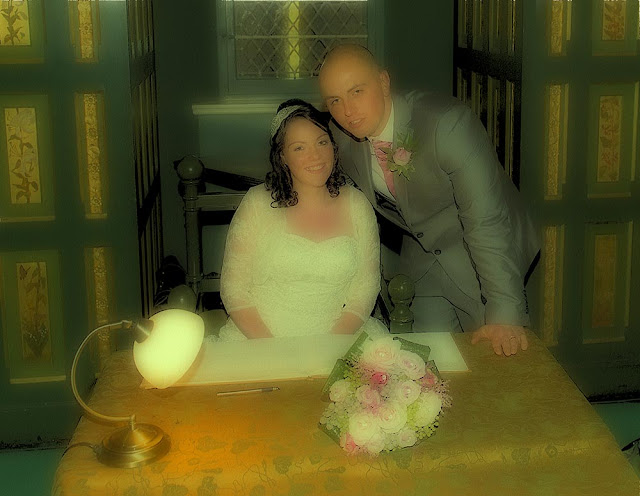Part One - Exercise 1.1 The origins of photomontage
Image 1
Distort layer added to a removal of some colour
Image 2
A vignette layer
Image 3
Glamour glow layer
Image 4
Polaroid transfer layer
Image 5
Stamp layer
Image 6
Stain Glass Window layer
In my images above I've purposely avoided repeating the style of Idris Khan whom I discuss below as his style of work I would like to be inspired from during this module and hopefully lead me toward my own derivation of result rather than replicate the work of Khan. However I find it very interesting and the art of manipulated image, or perhaps an un-manipulated images to create and an usual final image is something that would not initial be identified as photography. What I do like is that it draws photography into art and that makes for a very interesting proposition for me to explore
Idris Khan
Idris Khan is
British artist and though a non practicing Muslim, his interest in Islam and layered
imagery is traceable to his upbringing and influences elements of his work.
His work and
processes have been suggested to be “experiments in compressed” memories and
this very much resonates with me in looking at the layering of images in a
completely different way.
Khan
describes his approach to his work "...
a challenge to not define my work as a photograph but using the medium of
photography to create something that exists on the surface of the paper and not
to be transported back to an isolated moment in time."
One of his experiments was to photograph all 1,953 pages of
the Qur’an and digitally layer all these images. I think the most I have ever
done has been 10 layered images, one for a HDR image and the other using a macro
lens moving focus of a very thin focus window to create a fully focused image. I
wonder how long his PC took to complete the final image made up of all his
layered images.
He explains his work as often “repeating something constantly”.
There is an interesting exhibition video from the Fraenkal Gallery of Khan
being interviewed.
In an interview at the Sean Kelly Gallery in New York he is
quoted as saying:
“When I
make a piece of work I always feel that the most important thing is for it to
engage with the viewer on an aesthetic level first. The multi-layered
abstraction draws the viewer closer to the picture and then reveals something
else entirely. At this point, one can either attempt to understand the words or
accept not knowing the complete meaning of the text and fill the void with
their own ideas. This moment becomes self-reflective and an exploration of
one’s own belonging.”
Much of Khan’s work originates from photographs he has taken
himself or those he has borrowed His visual layering techniques have not been
limited to photographs but also videos
I've detailed below a few of his images that I'm particularly drawn to:
This image of St Paul's Cathedral is almost like an abstract line drawing and I quite enjoy how my mind tries to reconcile shape and order among the lines of the buildings
Initial, and line of the atrocities in Syria and around the world this initially appeared to me as a shell explosion where as it it appears to be a tree perhaps photographed in a uniform distance but across 360 degrees as the tree is very symmetrical and would lend itself to a layered image if the photographs are performed in this way. On close inspection I can see cars, almost as if ghosts and the theme I take from this is that trees and nature in general are more long lived as cars and perhaps this is exampled in their ghostly form in this final image
I've always been fascinated by space and all things related. |Whether this examples a gravity well or perhaps a black hole I don't know. It would be interesting if Khan associated this with a black hole itself and this would be very ironic since the gravitational power of a black hole is so immense that light cannot escape it and so as a result it would be impossible to be photographed
Khan in recognition of his services to art in 2017 was
awarded an OBE











Comments
Post a Comment